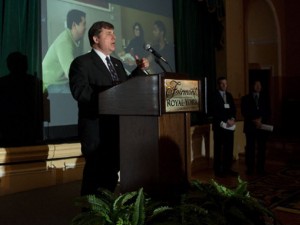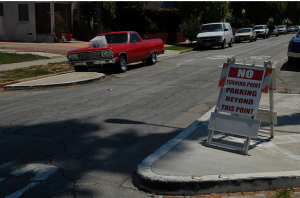Kodak Reports Progress on Sustainability Goals
 Eastman Kodak Company today reported it has reduced greenhouse gas (GHG) emissions by more than 50%, exceeding one of its Sustainability Goals a year ahead of schedule. Since the baseline year of 2002, Kodak has achieved a GHG reduction of more than 1.5 million tons, the equivalent of taking 350,000 cars off the road.
Eastman Kodak Company today reported it has reduced greenhouse gas (GHG) emissions by more than 50%, exceeding one of its Sustainability Goals a year ahead of schedule. Since the baseline year of 2002, Kodak has achieved a GHG reduction of more than 1.5 million tons, the equivalent of taking 350,000 cars off the road.
Kodak also reports progress today on its goal to improve the environmental attributes of its products. Using life cycle assessment-based tools and beyond compliance product standards, Kodak has enhanced the environmental profile of a number of products, including these for the graphics industry:
“We recognize that our customers not only want to know how we are performing on sustainability, but also how we can help them to be better stewards themselves,” said Charles Ruffing, Director, Health, Safety, Environment and Sustainability. “Our voluntary, public goal setting process has been very effective over the last decade plus in guiding us towards meeting both these expectations.”
Kodak was recently named to the Reputation Institute’s Top 50 ranking of Most Reputable Companies in the U.S. This recognition joins the other acknowledgements Kodak has received in the last year, including being named to the Dow Jones Sustainability Index (DJSI) and Newsweek’s Green List, as well as having received Platinum status from The Climate Registry, a leading authority on GHG emissions reporting.
A full report on Kodak’s progress on its current Sustainability Goals, as well as more information on Kodak’s Health, Safety, Environment and Sustainability performance, policies and procedures is available at Kodak .
2012 Sustainable Operations Summit Kicks Off April 17th in New York City
 President Bill Clinton, Actor & UN Goodwill Ambassador Don Cheadle, Rocky Mountain Institute’s Amory Lovins, Empire State Building’s Anthony Malkin, Rainforest Foundation’s Trudie Styler, NYC Department of Transportation’s Janette Sadik-Khan and Climate Scientist Michael E. Mann to Speak at Summit
President Bill Clinton, Actor & UN Goodwill Ambassador Don Cheadle, Rocky Mountain Institute’s Amory Lovins, Empire State Building’s Anthony Malkin, Rainforest Foundation’s Trudie Styler, NYC Department of Transportation’s Janette Sadik-Khan and Climate Scientist Michael E. Mann to Speak at Summit
President Bill Clinton, actor and environmentalist Don Cheadle, and the Founder of the Rocky Mountain Institute Amory Lovins, are set to appear at the 2012 Sustainable Operations Summit, which is bringing the brightest minds in business and sustainability to NYC to exchange economical solutions to address energy and the environment.
The summit will also feature a series of guided tours and receptions that will showcase ‘Sustainability in Action’ in New York City, including the World Trade Center site, the High Line and LEED Platinum Bank of America Tower at One Bryant Park. The opening night reception will take place on the 61st floor of the recently retrofitted Empire State Building. In addition, attendees will be able to network on a cruise aboard the greenest ship in the nation, The Hornblower Hybrid, which runs on renewable power generated by hydrogen fuel cells, solar panels and wind turbines. The Title sponsor of the summit is Dyson Airblade.
WHO: President Bill Clinton; Don Cheadle, actor and UN Environment Program Goodwill Ambassador; Amory Lovins, Founder of the Rocky Mountain Institute; Robert Hammond, Co-founder, Friends of The Highline; Tom Hicks, Deputy Assistant Secretary of Energy of the US Navy; Anthony Malkin, President, Malkin Holdings; Andreas Schierenbeck, President of Siemens Building Technologies; Trudie Styler, Co-Founder of the Rainforest Foundation; renowned Climate Scientist Michael E. Mann; NYC Department of Transportation Commissioner Janette Sadik-Khan; and Alex Knox, Industrial Design Director of Dyson.The 2012 Sustainable Operations Summit will be held April 17-19, 2012 at The Hilton New York. For a full list of speakers, please visit sustainablesummit.com.
University of Houston Law Center and University of Calgary Launch Joint Program in Energy Law
 Law students will learn to analyze complex emerging issues in energy and environmental sectors and earn degrees in U.S. and Canada
Law students will learn to analyze complex emerging issues in energy and environmental sectors and earn degrees in U.S. and Canada
The University of Houston Law Center and The University of Calgary today announced formation of the International Energy Lawyers Program. The initiative will allow students to earn both Canadian and American law degrees in four years. Students will spend two years at each school and take courses that will enable them to apply for admission to bars in the United States and Canada.
“Our two countries’ futures are intertwined economically, and one of the most important issues facing both countries is energy security,” said Ian Holloway, dean of The University of Calgary Law School.
“Training the next generation of lawyers who are leaders in energy and natural resources law will help us in our quest for sustainable, rational, continental energy policy.”
The driving force behind the International Energy Lawyers Program is a shared commitment to natural resource, energy and environmental law. UH Law Center and University of Calgary each enjoy international reputations as leading law schools in these areas and Houston and Calgary are leading energy centers.
“This is just the beginning of a collaboration that will extend beyond this program between two of the best law schools and two energy capitals in North America,” said Raymond T. Nimmer, dean of the University of Houston Law Center.
UH Law Center’s energy curriculum is one of the broadest in the nation and its Environment, Energy & Natural Resource Center is highly regarded worldwide. The new International Energy Lawyers Program will start in the fall.
The official kick off of the program will take place tonight during a signing ceremony at the Houston Livestock Show and Rodeo. Canadian Consul General, Paula Caldwell St-Onge, will be in attendance as will a number of executives from the energy industry and University of Calgary alumni from the Houston area.
Sprint Honored at 12th Annual Global Green Sustainable Design Awards for Samsung Replenish
 Sprint Nextel was honored at yesterday’s 12th Annual Global Green Sustainable Design Awards in New York City with the “Product Design” award for its collaboration with Samsung Telecommunications America (Samsung Mobile), the No. 1 mobile phone provider in the U.S.1, to design the eco-friendly2 mobile device, Samsung Replenish.
Sprint Nextel was honored at yesterday’s 12th Annual Global Green Sustainable Design Awards in New York City with the “Product Design” award for its collaboration with Samsung Telecommunications America (Samsung Mobile), the No. 1 mobile phone provider in the U.S.1, to design the eco-friendly2 mobile device, Samsung Replenish.
“Dan Hesse’s commitment and vision to building a more sustainable company; leading with innovative, sustainable solutions and improving operational efficiencies, has optimized our business, reduced costs and lessened our impact on the environment”
“It is an honor to be recognized by Global Green for our efforts to produce more eco-friendly devices,” said Steve Elfman, president of network operations and wholesale, who accepted the award on behalf of Sprint. “The award is a testament to our relationship with Samsung and the hard work of many who believe that technology and innovation can drive sustainable business solutions.”
Introduced to the market in May 2011, Samsung Replenish is the fourth eco-friendly device to be added to Sprint’s growing portfolio of green products and is Sprint’s first environmentally preferable Android Smartphone. The Replenish is 82 percent recyclable, has an optional solar battery charger, and is the first device in the U.S. to meet UL Environment interim standards for more sustainable mobile phones. The Replenish is also enabled with Sprint’s Green ID pack which lets customers personalize their device instantly with environmental-focused apps and mobile content.
The award also acknowledged Sprint’s corporate sustainability efforts, including reducing its carbon footprint, using renewable energy and promoting electronic recycling. Through Sprint’s Buyback program, customers can get up to $350 for recycling their old device and ensure that their old or unused mobile device is handled responsibly and kept out of the waste stream. Since 2001, Sprint’s wireless reuse and recycling take-back programs have kept more than 26 million wireless devices out of landfills.
“Dan Hesse’s commitment and vision to building a more sustainable company; leading with innovative, sustainable solutions and improving operational efficiencies, has optimized our business, reduced costs and lessened our impact on the environment,” added Elfman.
“We are proud that the Samsung Replenish is being honored by Global Green for its eco-friendly design and features,” said Johnny Hart, general manager for Samsung Mobile. “Samsung and Sprint have a long standing relationship and dedication to delivering eco-friendly products that don’t compromise features and functionality.”
Sprint’s industry-leading role in corporate responsibility and environmental sustainability continues to receive recognition. For the third year in a row, Sprint ranked near the top on Newsweek’s 2011 Rankings of America’s Greenest Companies at No. 3, up from No. 6 in 2010. Sprint was also ranked highest within the wireless sector on the Dow Jones Sustainability Index North America.
Greening Its Streets: City of Stamford, Conn., Will Save More Than $146,000 Annually with Switch to LED Streetlights
 Faced with shrinking budgets and expanding responsibilities, municipalities are being asked to do more with less when it comes to city improvements. The City of Stamford was up for the challenge when it began exploring how to light its town more efficiently. The resulting solution, a switch to energy-efficient LED streetlights, will save the city more than $146,000 annually.
Faced with shrinking budgets and expanding responsibilities, municipalities are being asked to do more with less when it comes to city improvements. The City of Stamford was up for the challenge when it began exploring how to light its town more efficiently. The resulting solution, a switch to energy-efficient LED streetlights, will save the city more than $146,000 annually.
“We looked at several manufacturers and thought the GE Cobrahead lights offered the best quality in terms of color temperature (4300 K), CRI, lighting uniformity and reduced glare.”
To jump-start the project, the city was awarded an Energy Efficiency and Conservation Block Grant, an initiative funding energy efficiency and conservation programs across the country. The grant paved the way for the city to replace more than 1,000 high-pressure sodium-based streetlights in the city’s main corridors with GE’s Evolve™ LED Roadway Medium Cobrahead (ERMC) fixtures. The project, Connecticut’s largest installation of LED streetlights, means a dramatic change in energy consumption for the city.
“The new LED streetlights are making an important contribution to Stamford’s sustainability efforts, as well as curbing costs and allowing us to light our beautiful streets with a really aesthetically pleasing light source,” says Nancy Pipicelli, energy/utility manager for the City of Stamford. “We looked at several manufacturers and thought the GE Cobrahead lights offered the best quality in terms of color temperature (4300 K), CRI, lighting uniformity and reduced glare.”
The award-winning GE LED ERMC system provides improved horizontal and vertical lighting uniformity, reduced glare and improved lighting control. The lights also consume just 95-157 watts per fixture, which is less than half that of consumed wattage under the city’s previously used high-pressure sodium vapor systems. Their estimated service life of more than 10 years (50,000-hour rated life) means that maintenance costs for the city also will decrease.
Thanks to the energy savings from the new lights, Stamford will receive a $357,000 rebate from Connecticut Light and Power, an electrical provider for the state of Connecticut. The city plans to use those funds to install an additional 467 energy-efficient streetlights using the GE LED Cobrahead technology next year.
Bay Area EcoFoodist Announces it will Hosts Food Sustainability Forum on September 21
 The EcoFoodist of the Bay Area announces it will be holding the First Annual Food Sustainability Forum on September 21 from 7 a.m. to 10 p.m. The event will be held at the Claremont Resort in Berkeley. The festivities will be highlighted by the appearance of Kiko Technology, a Hong Kong firm leading in advance technology – taking water to a new level. Kiko’s President, James T. Osugi will serve as a speaker and panelist for the event.
The EcoFoodist of the Bay Area announces it will be holding the First Annual Food Sustainability Forum on September 21 from 7 a.m. to 10 p.m. The event will be held at the Claremont Resort in Berkeley. The festivities will be highlighted by the appearance of Kiko Technology, a Hong Kong firm leading in advance technology – taking water to a new level. Kiko’s President, James T. Osugi will serve as a speaker and panelist for the event.
This will be the first of many Food Sustainable Forums that will advance the dialogue of alternative business models and solutions. These business models prove to be economically, socially and environmentally sound with proven methods and technology that promote long-term development of sustainable practices.
“What you eat is your business, safety and supply is our concern,” said Spencer Gillette, creator of EcoFoodist.
The First Annual Food Sustainability Forum will discuss different possible solutions and invite different companies to follow the EcoFoodist belief in clean and green living. A round table workshop will provide delegates with the opportunity to discuss business applications and solutions directly with entrepreneurs, government and non-governmental organizations and corporations.
Eco-Cocktails will serve as the key-networking event of the forum. This will be followed by an announcement of the Eco-Cocktail Competition winner. The closing dinner ceremony will be held at the Claremont Hotel Club & Spa, Sonoma Ballroom located at 41 Tunnel Road in Berkeley and will feature a very special guest appearance.
Visit The EcoFoodist at www.ecofoodistregistration.com/ to register for the event or call (510) 466-6378 to gather more information about the forum.
About The EcoFoodist
The EcoFoodist in the Bay Area is dedicated to the advancement of life by advocating and promoting the development of environmentally conscious, safe and economical food enterprises around the world. With Spencer Gillette’s 20 years of experience as a Food Service Executive, The EcoFoodist is gradually growing by inviting food corporations to learn and apply food system sustainability.
Culver City Walks, Not Runs, Towards Transportation Sustainability
 The start of the Downtown Connector at the intersection of National Blvd. and Wesley St. The bicycle friendly street contains Sharrows, signage, narrow roads, and some traffic calming.
The start of the Downtown Connector at the intersection of National Blvd. and Wesley St. The bicycle friendly street contains Sharrows, signage, narrow roads, and some traffic calming.
Following the decline of the studios in the 1960′s and 1970′s, Culver City had to reinvent itself. In the 1990′s, the city once commonly referred to as “The Heart of Screenland” undertook an aggressive campaign to revitalize their Downtown area that was mostly successful in attracting businesses and tourists to bolster the city’s economy. Today, nearly 40,000 people call Culver City home, and it’s widely thought of as a safe place to live and a good place to raise children.
Despite its reputation for embracing New Urbanism (in 2007 the New York Times called the city a “nascent Chelsea”), Culver City had never embraced transportation planning for cyclists and pedestrian. In fact, when the City approached the L.A. County Public Health Department about a PLACE Grant, it had never had either a bicycling or pedestrian element in its Master Plan. While critics of the plan, including some of the people that helped create it, complain that the plan isn’t as progressive or specific as it should be, for a city that was literally starting with no foundation or advocacy community, to create change this is a crucial first step.
The lack of a bicycle and pedestrian plan of any sort was a major reason Culver City was awarded the PLACE grant, because in many ways it is a city that is doing well. Obesity statistics, especially those for grade-school age children are lower than the national average. In addition, Walk Score, an organization that looks at waklability on a national scale recently ranked Culver City as a “very walkable” community.
As any parent of a toddler can tell you, you have to learn to walk before you can run. When it comes to planning for people-powered transportation, Culver City is walking, and the fruits of that walk are a brand new Bicycle and Pedestrian Master Plan .
Or, as Ron Durgin, President and Co-Founder of Sustainable Streets and a member of the master plan’s citizen advisory committee, put it, “These are the broad strokes they’re going to need to move forward.”
It’s long been accepted that auto-dependency leads to poor air quality, as pollutants spewing from tailpipes have been blamed for a laundry list of human ills including many lung conditions (such as asthma) and neurological disorders (such as autism .) However, modern public health experts are looking at the ills of car dependency in a new light, noting that areas with poor sidewalks tend to have higher obesity, that there is a correlation between a drop in children walking and biking to school and an increase in childhood obesity and that cities with more bike lanes have healthier overall populations. Some research even points to improved mental health for those who take regular walks or bike rides.
With $320,000 in public health money in-hand, the City embarked on a three-year process to create its first Bicycle and Pedestrian Master Plan, which serves as both a collection of projects that the city hopes to complete in the next five years and a vision for a Culver City that encourages walking and cycling in a very real way.
“The City of Culver City is extremely grateful to the LA County Department of Public Health’s PLACE program for providing us with grant funding. The County made it possible for us to create the City’s first Bicycle and Pedestrian Master Plan (BPMP)’” writes Culver City Mayor Michael O’Leary. ”The process of developing the BPMP engaged the community like never before in bicycle and pedestrian issues. The resulting documents will help shape the City for years to come by communicating clear goals and by identifying priorities for improvements in bicycle and pedestrian infrastructure. We are dedicated to providing educational, encouragement and enforcement efforts in the future.” Posted By Damien Newton – Download the full article: Streetsblog Los Angeles » Culver City Walks, Not Runs, Towards Transportation Sustainability » Print .
